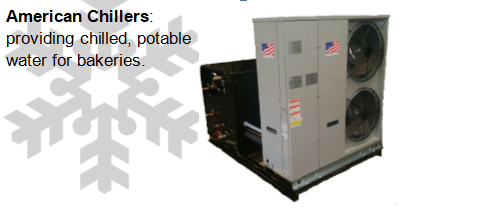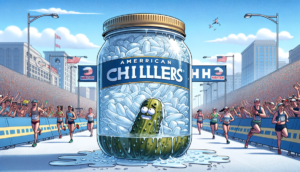Chillers are used in many applications. Almost every product that you can see or touch requires cooling at some point during its manufacture, including bakery products.
So what is a bakery chiller? A bakery chiller is a potable water chiller that provides on-demand cold water at temperatures around 38F degrees, at a low flow and pressure. This chilled water stabilizes the yeast and stops it from growing.
What type of chiller is needed for a bakery and why?
The type of chiller needed for a bakery is one that provides on-demand, potable, chilled water in and around 38F degrees. The potable chilled bakery water is used in dough making to control the growth of the yeast. The cold water slows down yeast growth.
What is Special About a Bakery Chiller?
Bakery chillers are special or different than normal off-the-shelf chillers in a couple of different ways. First, a bakery chiller requires potable water (clean drinking water). American Bakery Chillers use a double wall tube in tube sanitary heat exchanger to help prevent the refrigerant and oil in the refrigeration side from contaminating the water should there be a breech. Secondly, bakery chillers are most often batch type chillers.
What is batch cooling?
Batch cooling is were a specified amount of water is drawn out of the system to be used in a batch type application like the designated amount of cold water required as part of an ingredient list. A batch is different than a continuous flowing single pass chiller.
Do You Need to Know
the Size of the Batch to Size the Chiller?
Yes, it is helpful in knowing the size of the batch and time between batches.
This allows our engineers to size a chiller that is appropriate for the job,
which is often smaller than a standard chiller.
Why is a Batch Chiller Smaller than the
Btu load?
The batch chiller uses an integral storage tank. The more time between
batches, the more time a chiller has to chill the water in the storage tank and
the smaller chiller is required.
Batch Cooling in Simple Terms
To put it in very simple terms, the bakery chiller tank works like a buffer
giving the chiller time to catch up in between batches. It’s like putting a cup
of warm water in the refrigerator, then taking it out 5 minutes later VS
putting a cup warm of water in the refrigerator and coming back in one hour.
The cooling capacity of the refrigerator hasn’t changed.
Any Other Special Considerations?
Yes, it may be important to use a low pressure, low flow pump. Why is this
needed? It is needed to keep aeration in the water to a minimum and pressure
out of the tap kept to a minimum.
What is American
Chillers Experience with Bakery and Batch Chillers?
American Chillers has years of experience with bakery and batch cooling. Our
founder began making bakery chillers in the 1980’s. Our offering has evolved
and improved over the years with new refrigerants and components coming on the
market.
What Maintenance is Required on a Bakery
Chiller?
Bakery chillers are typically installed indoors. The most common maintenance is
to keep the condenser coils cleaned on air-cooled units. It is also advised to
go through a detailed maintenance check list on the chiller on a regular basis.
American Chillers recommends maintenance and preventative maintenance checks
every 3 months. Included in this check to make sure wire connections are tight,
checking voltage and amp draws and giving the chiller an all-around visual inspection.
What is the Typical Lead Time when
Purchasing a Bakery Chiller?
Typical lead times are from 4 to 6 weeks, but can vary depending on stock,
production schedules and availability of parts.
What do You Need to do to Size a Bakery Chiller?
Contact our sales department at 803-822-3860 or via the contact form on this website. A salesperson will assist ask you about your process, take down your contact information, answer any questions that you may have, size your chiller and provide you with a quote and specifications.
Related Questions
What other types of chillers are used in food processing?
Chillers are also used to cool mixers and jacketed tanks in food processing. Mixers generate heat which can be transferred to the food if not controlled and they could also over heat. Many food processing applications require the product ingredients to be mixed in a jacketed tank. The chiller circulated fluid through the jacket to maintain or cool down the food-based products to the desired temperature.
What is a brewery
glycol chiller?
Breweries use chillers to maintain their fermenters at optimal temperatures
to best control the yeast during fermentation. Keeping the fermenters at a
specified temperature allows the Brewmaster to better control and replicate
each batch of beer. When fermentation is complete, the temperature of the beer
is lowered to 33F degrees in order to rapidly stop fermentation. Glycol (food
grade HVAC type anti-freeze) is used as a cooling fluid and is pumped through
jackets in the fermentation tanks to keep the fluid in the chiller evaporator
(heat exchanger) from freezing.




